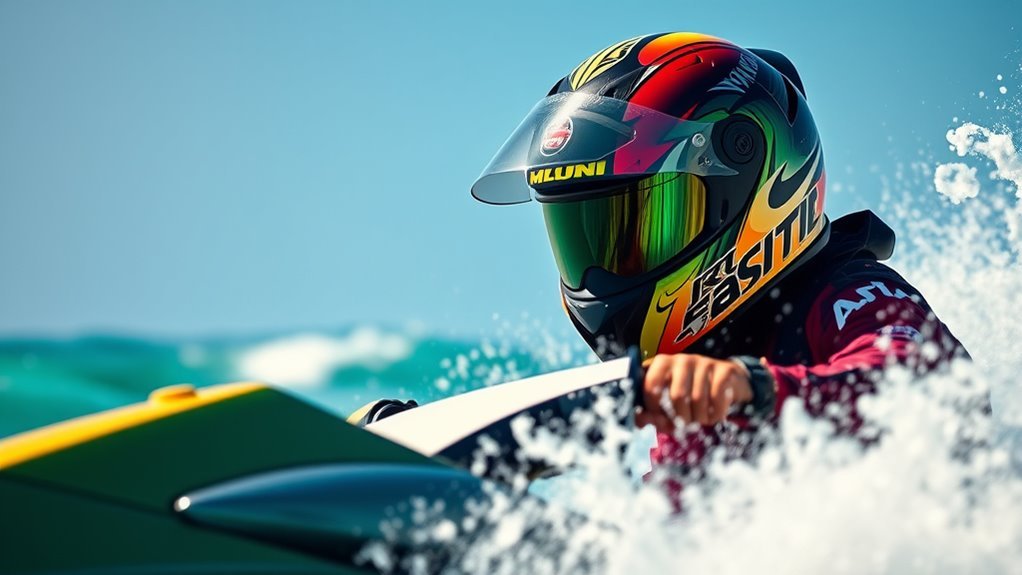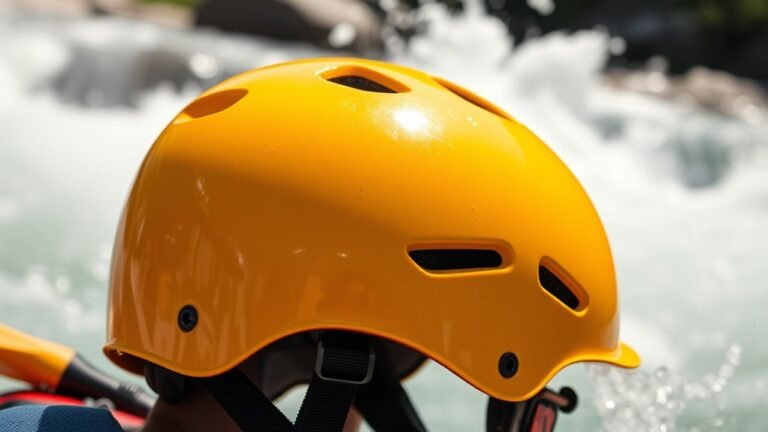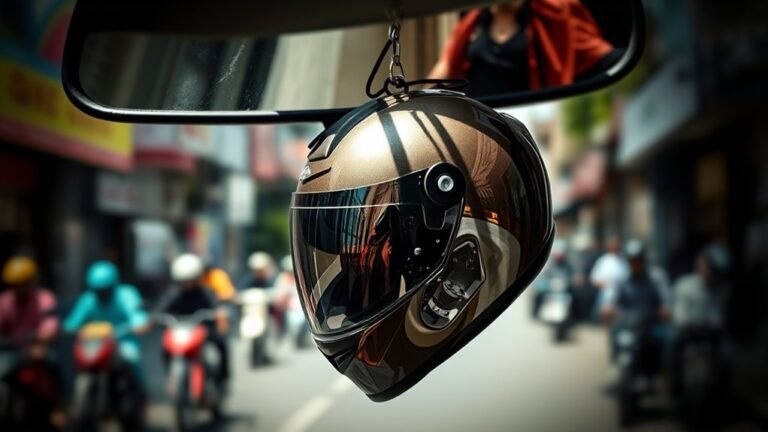Helmet Use in Jet Ski Racing
Wearing a helmet in jet ski racing is essential for your safety. High speeds and unpredictable water conditions elevate the risk of serious head injuries. Helmets reduce the severity of injuries during crashes and promote overall well-being while racing. They also reflect a commitment to safety standards set by racing organizations. Choosing the right helmet can enhance your comfort and performance on the water. Discover more about helmet selection and regulations for ideal protection.
The Risks of Jet Ski Racing
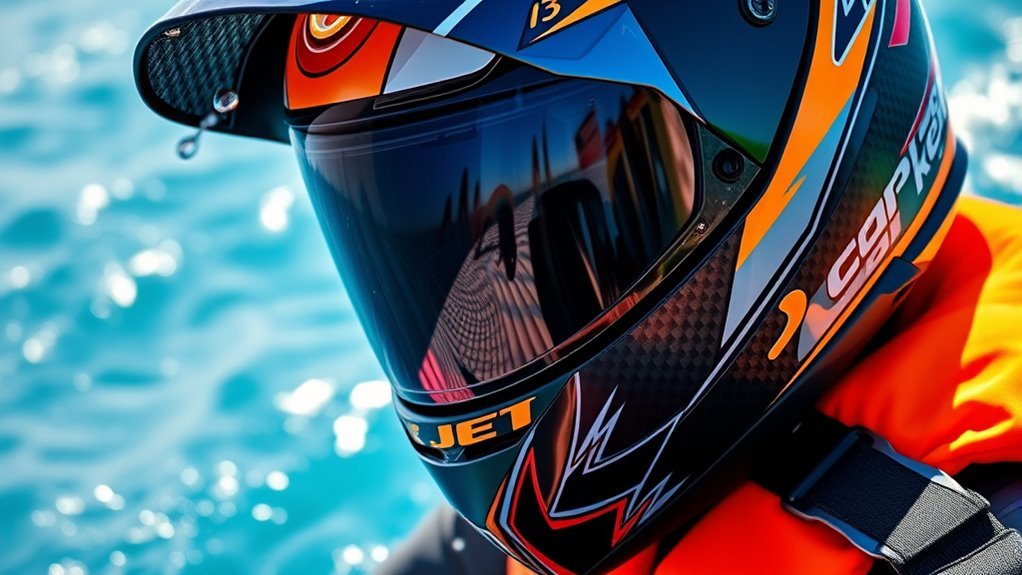
Jet ski racing presents a myriad of risks that every participant should acknowledge before hitting the water. While the thrill of speed can be exhilarating, it’s essential to implement safety precautions to mitigate potential dangers. High speeds and unpredictable water conditions can lead to serious injuries, especially without proper training and awareness. Prior to racing, make sure you’re familiar with your jet ski’s handling and local regulations. Always perform pre-race checks to confirm equipment functionality. Wearing appropriate gear, including life jackets, can greatly reduce injury risks. Remember, injury prevention isn’t just about physical safety; it’s also about understanding your limits and respecting the water. By prioritizing these safety measures, you can enjoy the freedom of jet ski racing while minimizing hazards.
Importance of Helmet Use
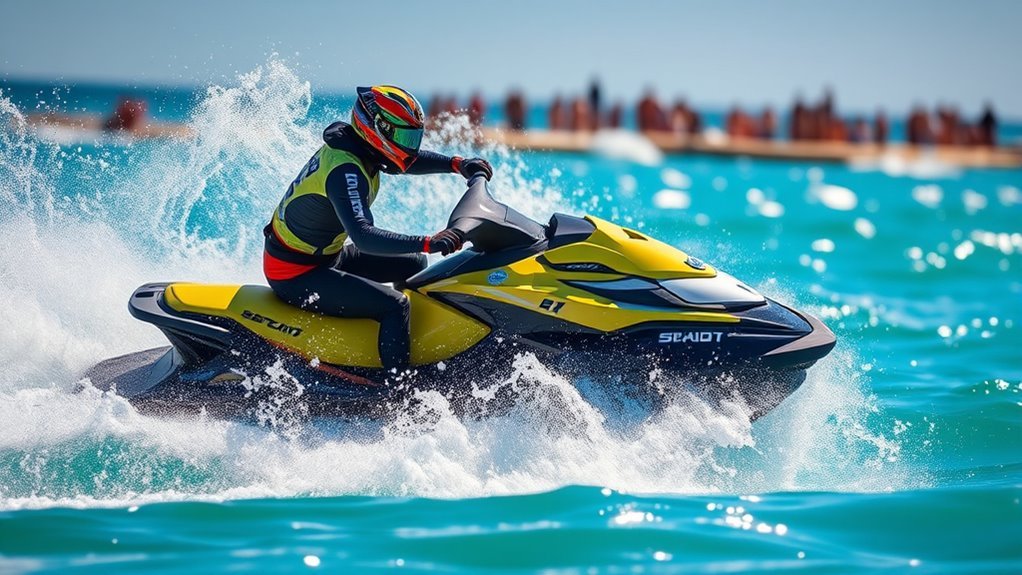
When it comes to racing on the water, the use of helmets often gets overlooked, yet it plays an essential role in ensuring safety. You might feel invincible out there, but helmet safety can’t be underestimated. High speeds and unpredictable water conditions increase the risk of accidents, making proper head protection critical. A helmet can greatly reduce the severity of injuries during a crash, which is essential for injury prevention. By choosing to wear a helmet, you’re not only protecting yourself but also setting an example for fellow racers who value freedom and adventure. Remember, the thrill of jet ski racing shouldn’t come at the cost of your well-being. Prioritizing helmet safety means you can enjoy the ride while minimizing risks.
Current Helmet Regulations in Racing
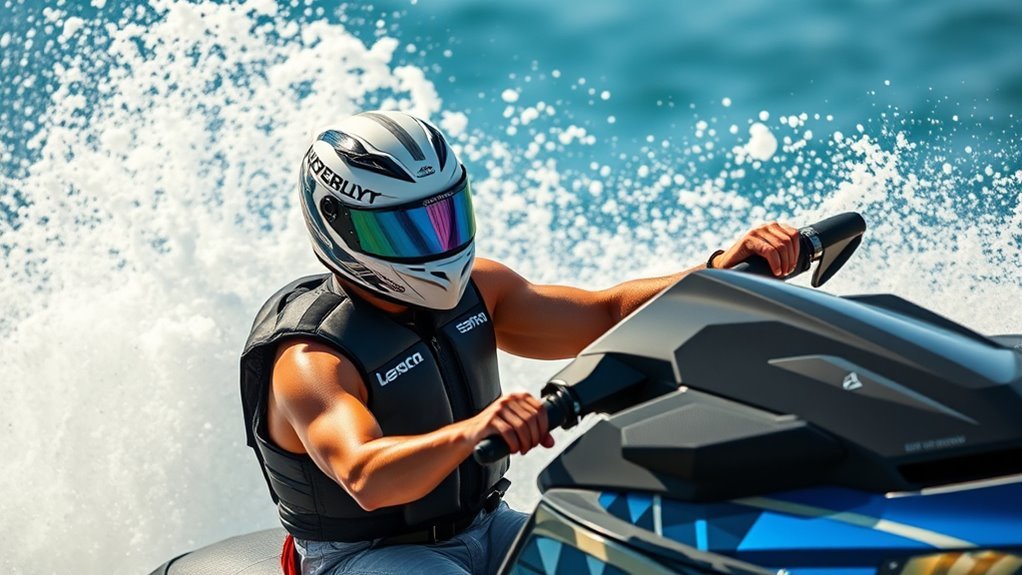
While many racers might focus on speed and technique, understanding the current helmet regulations in jet ski racing is vital for compliance and safety. Racing organizations mandate specific helmet standards to guarantee that all participants are adequately protected. Helmets must meet or exceed certain safety certifications, typically established by recognized authorities. These regulations often vary by organization, so it’s important to check which standards are applicable to your events. Additionally, helmets should feature secure chin straps and proper fit to maximize protection during races. By adhering to these guidelines, you safeguard not just your performance but also your well-being on the water. Embracing these regulations reflects a commitment to both personal freedom and responsibility within the sport.
Benefits of Wearing a Helmet
Wearing a helmet in jet ski racing offers numerous benefits that can greatly enhance your safety and performance. To begin with, helmets provide essential safety enhancements by protecting your head from impacts, ensuring you’re less likely to suffer severe injuries. Additionally, a well-fitted helmet can improve your aerodynamics, allowing you to cut through the water more efficiently, thereby boosting your performance.
| Benefits | Description | Impact on Racing |
|---|---|---|
| Safety Enhancements | Protects against head injuries | Increased overall safety |
| Injury Prevention | Reduces risk of concussions and trauma | Confidence to push limits |
| Comfort | Keeps you focused by minimizing distractions | Better concentration |
| Performance Boost | Enhances aerodynamics | Faster lap times |
Using a helmet isn’t just smart; it’s essential for every racer.
Tips for Choosing the Right Helmet
Choosing the right helmet for jet ski racing is crucial, as it directly impacts your safety and performance on the water. First, look for helmet features that enhance comfort and visibility, such as ventilation systems and a streamlined design. A well-fitted helmet won’t shift during high speeds, guaranteeing maximum protection. Next, verify the helmet meets relevant safety certifications, like DOT or Snell, which indicate it’s been tested for impact resistance. Consider materials like carbon fiber for lightweight durability. Finally, don’t overlook the importance of style—pick a helmet that reflects your personality, making you feel confident while racing. By focusing on these elements, you’ll find a helmet that balances safety with the freedom to enjoy the thrill of jet ski racing.
Frequently Asked Questions
Can I Use a Regular Motorcycle Helmet for Jet Ski Racing?
You can’t use a regular motorcycle helmet for jet ski racing. While it might seem convenient, motorcycle helmets typically don’t meet the specific safety standards required for water sports. They lack the necessary water resistance and drainage features, which are essential for preventing water buildup. Instead, opt for a helmet designed for jet skiing to guarantee maximum safety and performance. Your freedom on the water depends on having the right gear to protect you.
How Often Should I Replace My Racing Helmet?
You should replace your racing helmet every five years, even if it looks fine. Helmet care is vital; regular inspections for cracks or damage are essential. Safety standards evolve, and older helmets may not meet current regulations, compromising your protection. If you’ve had a significant impact or crash, replace it immediately. Prioritizing your safety doesn’t restrict your freedom; it enhances your experience on the water, allowing you to ride confidently and enjoyably.
Are There Specific Brands Recommended for Jet Ski Helmets?
Yes, there are specific brands recommended for jet ski helmets that prioritize helmet safety. Brands like Shoei, Bell, and HJC are known for their quality and reliability. When making brand comparisons, consider factors like fit, weight, and safety ratings. It’s essential to choose a helmet that not only meets safety standards but also provides comfort while you’re racing. Don’t compromise on protection; your freedom on the water depends on it.
Do Helmets Have an Expiration Date?
Think of your helmet like a trusty steed; it needs care and attention to keep you safe on the wild ride. Helmets do have an expiration date, typically around five years, due to the wear and tear that affects their helmet lifespan. Safety standards evolve, and materials can degrade over time, reducing effectiveness. Regularly inspect your helmet, and if it’s nearing its expiration, consider replacing it to guarantee your freedom out on the water.
Can Helmets Be Customized for Better Comfort?
Yes, helmets can be customized for better comfort. You can achieve a custom fit by adjusting the interior padding options, which helps guarantee the helmet sits snugly without being restrictive. Many brands offer various padding thicknesses and materials, allowing you to personalize the helmet to your liking. This customization not only enhances comfort but also promotes safety by guaranteeing the helmet stays securely in place during use, giving you the freedom to focus on your ride.
